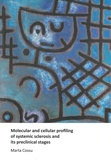Molecular and cellular profiling of systemic sclerosis and its preclinical stages

Cossu, Marta
- Promoter:
- Prof.dr. T.R.D.J. (Timothy) Radstake
- Co-promoter:
- Dr. H. (Harry) Dolstra & dr. M.C. (Madelon) Vonk
- Research group:
- Radstake
- Date:
- September 7, 2017
- Time:
- 14:30 h
Summary
The development of unrestrained fibrosis in the skin and internal organs is the hallmark of systemic sclerosis (SSc). Nevertheless, it is known that fibrosis is preceded by vascular and immune modifications. Early SSc (EaSSc) individuals presenting with Raynaud’s phenomenon and SSc-specific circulating autoantibodies and/or SSc-specific modifications of the capillaries and no other feature indicative of definite disease are considered at increased risk to develop SSc when compared with the general population. Furthermore, some characteristic SSc features (digital ulcers, puffy fingers, telangiectasia) are actually not fibrotic, they can precede the fibrotic ones and still be sufficient to meet the new EUropean League Against Rheumatism (EULAR)/American College of Rheumatology (ACR) classification criteria for SSc.
In my thesis I aimed to characterize how patients with EaSSc and SSc without any clear sign of fibrosis yet differ from SSc patients already showing fibrosis (the limited and diffuse cutaneous SSc; respectively, lcSSc and dcSSc), by that contributing to increase the knowledge about the events which lead to the onset of fibrosis and provide new ground for therapies able to prevent it.
To do so, we first investigated how different factors involved in vascular and immune activation “behave” in the circulation of early SSc individuals, in patients with SSc without fibrotic features, comparing with SSc patients with clear signs of fibrosis. We then investigated in the different patient groups natural killer (NK) and NKT-like cells, important in controlling infections, tumor development and the activation of other immune cells.
We found that:
- the Interferon (IFN) signature, an immunological trait described in SSc patients with fibrosis, is already present since the EaSSc stage and in the non-fibrotic SSc group to a even higher extent then in fibrotic SSc patients;
- markers of vascular damage (angiopoietin-2, CXCL16, E-selectin, ICAM-1) are already elevated in the circulation of EaSSc patients and in a gradually increasing fashion in patients with SSc without fibrotic features and to the highest degree in fibrotic SSc patients, mirroring the same deteriorating trend in clinical parameters (inflammation indicators, lung involvement) from EaSSc to non-fibrotic SSc and finally to the lcSSc and dcSSc subsets;
- CXCL10, CXCL11, TNFR2 and CHI3L1 can clearly distinguish patients with EaSSc and even more the ones with SSc without fibrotic features from healthy controls (HC). Furthermore, within each patient group, the patients who faster evolved (EaSSc developing full-blown SSc and non-fibrotic SSc developing fibrotic features) were the ones with the highest circulating levels of CXCL10 and TNFR2;
- NK and NKT-like cells from EaSSc and non-fibrotic SSc patients produce higher levels of pro-inflammatory/pro-fibrotic molecules (TNF-α, IL-6) than HC in response to different activating triggers;
- in the circulation of patients with the most extensive skin fibrosis, dcSSc - but not in early SSc nor in patients with SSc without fibrosis -, a reduction of NK cells expressing the activating receptor NKp46 and of NKT-like cells expressing Killer-Immunoglobulin-like (KIR) receptors are observed. These patterns suggest that in dcSSc patients both NK and NKT-like cells could be less functional. This hypothesis was confirmed by applying in vitro cytotoxicity assay. Moreover, on the basis of the data available in literature for other autoimmune diseases and on our data on NK and T cells from patients with rheumatoid arthritis and psoriatic arthritis, these expression patterns seem rather specific for SSc.
We are able to conclude that:
- the SSc subset without fibrotic features stratifies in an intermediate clinical and molecular severity stage between EaSSc - the mildest – and fibrotic SSc – the most advanced;
- there are immune modifications which are differently expressed throughout the distinct disease stages (“pre-SSc”, pre-fibrotic, fibrotic): they characterize the earliest phases and the patients who faster evolve;
- NK and NKT-like cells, cell populations until now neglected in SSc research, offer new possible targets (NKp46, KIR) to validate and whose implication in SSc pathogenesis and therapy should be further investigated.
With the work described in my thesis and herein summarized, we don’t aim to propose a new classification system, but to stress the molecular and clinical heterogeneity of SSc and the need for a more accurate patients stratification. We are convinced that a more precise classification (clinical and molecular) to be achieved by assessing different parameters (e.g. inflammation-, metabolism-, vascular activation-related) in multicentric, longitudinal, cohort studies, will lead to the development of refined options for treatment, because those will be more targeted on the mechanisms which underlie the pathogenetic process in the different stages of disease.